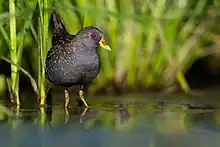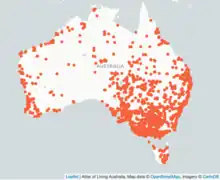Australian crake
The Australian crake (Porzana fluminea), also known as Australian spotted crake, or spotted crake is a species of bird in the family Rallidae.[2] It is the only species of Australian crake in the genus Porzana.[3][4]
.png.webp)
| Australian crake | |
|---|---|
 | |
| In New South Wales, Australia | |
| Scientific classification | |
| Domain: | Eukaryota |
| Kingdom: | Animalia |
| Phylum: | Chordata |
| Clade: | Dinosauria |
| Class: | Aves |
| Order: | Gruiformes |
| Family: | Rallidae |
| Genus: | Porzana |
| Species: | P. fluminea |
| Binomial name | |
| Porzana fluminea Gould, 1843 | |
Description
The Australian crake measures 19–23 cm (7.5–9.1 in) in length, weighs 55–70 g (1.9–2.5 oz) and has a wingspan of 27–33 cm (11–13 in).[6][7] It is similar in appearance and behaviour to Baillon's crake (Porzana pusilla), but the Australian crake is stockier and darker overall and lacks the distinctive barred undertail of the Baillon's crake (Porzana pusilla).[7] The Australian crake has a sooty face with steel-blue/dark grey breast, belly and throat. Brown upperparts, including the crown, are streaked black and white, with barred black and white flanks.[2][3] Shorter undertail coverts are black and longer undertail coverts are white, forming a distinctive upside down V when tail is cocked.[2][8] The outermost primaries have a distinctly white leading edge that is visible during flight.[6] The bill is yellow-green with red base to upper mandible and measures 1.8–2.1 cm (0.71–0.83 in).[9] Legs and feet are also yellow-green and the iris is red.[3][2][8] While Gould asserted in The Birds of Australia (Gould) that "the sexes present so little difference in colour, that they are only to be distinguished by dissection",[10] it can be noted that the female is slightly smaller and paler than male with a brown stripe across upper lores and more defined white spots on breast and neck.[6] Immature birds are paler again with white fringed plumage on belly and breast appearing like muted barring.[6][3] Juveniles are similar to adults but lack the steel-blue/dark grey plumage and instead have brown and white speckled underparts, as well as a brown iris and no red on bill. Chicks have very plumulaceous black feathers with a deep green hue and a distinctive, red blaze to base of upper mandible.[8]
Taxonomy
Australian birds have been significant to First Nations peoples for tens of thousands of years, linguistic and ornithological research in this area is needed to identify the specific significance and naming of this species within individual Nations.[11] The Australian crake was given its taxonomical name (Porzana fluminea) by John Gould in 1843, when he described it in Volume VI of his work The Birds of Australia (Gould).
Distribution and habitat

Endemic to Australia, the Australian crake can be found throughout southeast and Western Australia. It is less common in Tasmania and tropical areas of northern Australia.[3] The Australian crake lives in both coastal and inland habitats in freshwater, brackish, marine and terrestrial environments where it prefers densely vegetated areas of marshes, swamps, estuaries and saltmarshes that support lignum, chenopods, rushes and sedges. [3][13][9][8] Distribution and movement is dependent on water conditions, so following periods of high rainfall, range can extend inland to areas like Alice Springs/Mparntwe.[3]
Ecology
Diet
Foraging often occurs in pairs, family groups and sometimes, when food is abundant, in large groups of up to 100 individuals.[6] Densely vegetated areas amongst reeds, on mudflats or in shallow water (below 5cm in depth) are favoured, where a variety of foods are enjoyed including; aquatic plants, algae, seeds, molluscs, crustaceans, spiders, tadpoles and insects, both adult and larval, in orders including Dermaptera, Orthoptera, Coleoptera, Diptera, Lepidoptera and Hymenoptera.[14][9][6] These birds forage by probing the ground, wading and swimming, submerging their heads underwater and knocking larger food items against the ground by the water's edge.[6]
Breeding and nests
Breeding occurs between August–February.[9] Nests are often over or beside water 2–50 cm (0.79–19.69 in) above waterline within reeds, rushes, grasses and low shrubs. Additional nesting materials of rushes or grasses are laid over the nest in an inverted dome shape, and foliage is often flattened in an approach-ramp or stage leading up to the nest.[14][9] Nests of individual mating pairs are often found together, with as many as 30 individual nests in a group.[6] Clutches are of 3-6 eggs that are pale brown with dark brown, red-brown and black spots.[15]
Conservation
Although the Australian crake is listed as Least Concern, habitat loss, invasive and feral animals, agriculture and livestock grazing and climate change are threats to this species and the conservation of wetlands is fundamental to the survival of this species.[16]
References
- BirdLife International (2016). "Porzana fluminea". IUCN Red List of Threatened Species. 2016: e.T22692680A93363806. doi:10.2305/IUCN.UK.2016-3.RLTS.T22692680A93363806.en. Retrieved 12 November 2021.
- "Australian Spotted Crake - eBird". ebird.org. Retrieved 2022-06-18.
- Pizzey, Graham (1980). The field guide to the birds of Australia. Sydney: Collins. ISBN 978-0-7322-9193-8. OCLC 505187991.
- "Finfoots, flufftails, rails, trumpeters, cranes, Limpkin – IOC World Bird List". www.worldbirdnames.org. Retrieved 2023-07-07.
- G, Broinowski. 1891.The Birds of Australia, Tabuan Water Crake Or Sooty Crake, (colour litho). https://www-bridgemaneducation-com
- Taylor, Barry (30 August 2010). Rails : a guide to the rails, crakes, gallinules and coots of the world. A&C Black. ISBN 978-1-4081-3537-2. OCLC 1053858279.
- Campbell, Iain (2015). Birds of australia : a photographic guide. Princeton University Press. ISBN 978-1-4008-6510-9. OCLC 884015045.
- Menkhorst, Peter (August 2019). The Australian bird guide. CSIRO. ISBN 978-1-4863-1193-4. OCLC 1096383391.
- George Adams (2018). Complete guide to Australian birds. North Sydney, NSW. ISBN 978-0-14-378708-2. OCLC 1046086429.
{{cite book}}: CS1 maint: location missing publisher (link) - "Volume VI". Trove. Retrieved 2022-06-20.
- "Complete index of all Australian bird species". mdahlem.net. Retrieved 2022-06-20.
- Atlas of Living Australia website. Species page: https://bie.ala.org.au/species/urn:lsid:biodiversity.org.au:afd.taxon:9a82127d-8ffa-4aa7-bcb6-e1ef527cb67d#gallery. Accessed 17 June 2022.
- "Australian Crake (Porzana fluminea) - BirdLife species factsheet". datazone.birdlife.org. Retrieved 2022-06-18.
- "Australian Spotted Crake | BIRDS in BACKYARDS". www.birdsinbackyards.net. Retrieved 2022-06-19.
- "Explore our Egg Collection | Western Australian Museum". museum.wa.gov.au. Retrieved 2022-06-19.
- AWE. "Wise Use Wetlands Factsheet" (PDF). AWE. Retrieved 17 June 2022.
 Media related to Porzana fluminea at Wikimedia Commons
Media related to Porzana fluminea at Wikimedia Commons Data related to Porzana fluminea at Wikispecies
Data related to Porzana fluminea at Wikispecies
